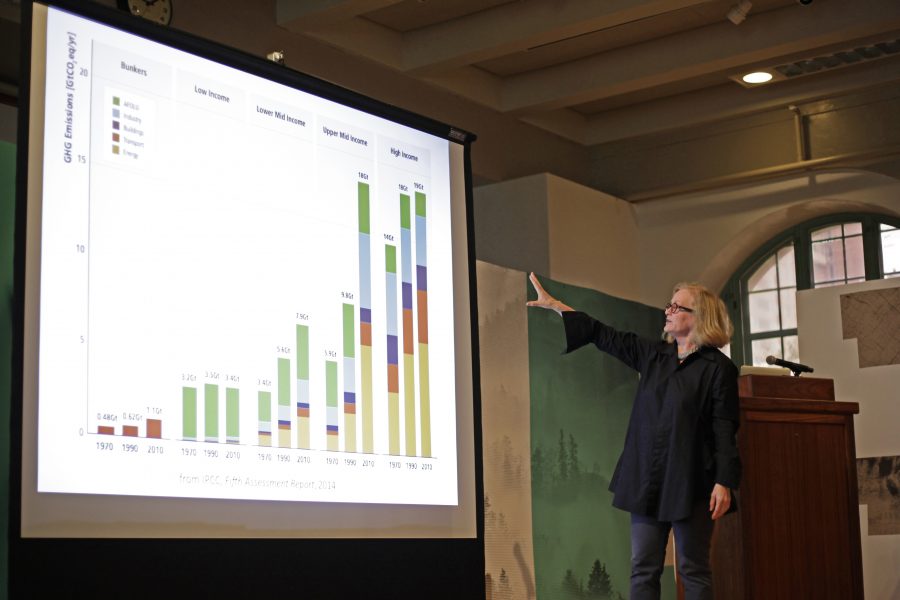Wood can take us a step closer to a sustainable future.
That future is wrought with substantial difficulties, such as that expressed by UK architect and speaker Andrew Waugh when he described the coming challenges for architects.
“We will need 85 billion square meters of new housing by 2035,” Waugh said. “That is the work at hand.”
He said that in order to satisfy this demand responsibly, architects must understand the environmental implications of building with timber.
Time for Timber’s symposium brought together diverse perspectives like Waugh’s to help understand wood as a resource in architecture and building. Engineers, designers, architects and thinkers weighed in on the advantages, limitations, future applications and ecological concerns of using timber in buildings.
Grace Jeffers is a writer, historian, artist and advocate for the decaying presence of primary growth forests, which are forests that have yet to be harvested or touched by human development.
Jeffers said she hopes to instill a concern for not only where timber materials come from, but what they represent. She wants builders and designers to understand that while trees might grow back, ancient forests and all the wildlife and complex ecosystems they contain, cannot.
In illustrating this point, Jeffers described a tree plantation she witnessed in the Amazon. While on a tour of the rainforest, her group happened to pass through a tree farm. As she moved from being in the natural, indigenous rainforest into the invasive, non-native tree farm, she said everything fell silent. There wasn’t a hint of wildlife to be seen.
Current industry standards view such a farm as a sustainable practice for harvesting wood. Jeffers wants to challenge that perception.
“Tree farms are a good idea in theory, but do they work in practice?” Jeffers said.
Jeffers asked architects to leave the lecture with the mindset of asking similar questions, because ultimately, it is this collective effort and vigilance that will incite change.
UT alumna Ilse Frank owns landscape architecture firm Studio Balcones, which designed the familiar University Avenue monument sign in front of the Tower. She attended the event, and said Jeffers strengthened her view on wood as a resource.
“I think I knew its value already,” Frank said. “This reinforced that and made me realize it’s very important to think about. You can’t design in a vacuum and you can’t design just for aesthetics – you have to think about a lot of things. If we’re the ones in power to specify (which products we use) we are the ones with the power to change that process.”
Jan-Peter Koppitz is a structural engineer who works for the London-based engineering firm ARUP and was the project manager for the iconic Metropol Parasol in Seville. His projects push the limits of timber and apply the material in unexpected, gravity defying ways. Koppitz is a proponent of wood and hopes to change perceptions with his work.
He discussed the diverse applications, limitations and technical challenges of working with wood. His projects and research examine what timber can provide a building.
“We have to challenge the industry with projects that demonstrate the capabilities and also limitations of timber buildings,” Koppitz said. “The U.S has restrictive code that limits what we can do with timber in our buildings — research can change that.”
Dean of the School of Architecture Michelle Addington spoke about a realistic definition of sustainability, in that there is no simple answer when talking about sustainability. Instead of searching for the silver bullet that will solve all of the worlds problems, she said a series of microsteps that can lead to progress.
“We are really in this as one collective body, not just as our individual selves,” Addington said.
Event organizer and associate professor Ulrich Dangel said he sincerely hopes that this event was a good venue for exchange of ideas and critical discussions around timber across disciplines.
Time for Timber’s accompanying exhibition features displays of building materials and impressive timber structures located around the world and is ongoing and open to the public 8 a.m. –5 p.m., Monday through Friday, through Feb. 28, located in the Mebane Gallery of Goldsmith Hall.















